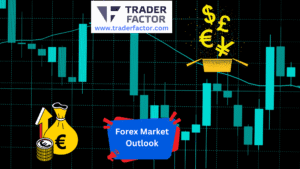The market outlook is set to focus on key events shaping economic sentiment and financial movements in the coming days. The JOLTS Job Openings report provides crucial insights into U.S. labor market dynamics, while the Non-Farm Payroll data will shed light on employment growth and wage trends. Adding further weight, Federal Reserve Chair Jerome Powell’s speech on monetary policy could signal shifts in the central bank’s future actions. Together, these events are expected to drive significant market activity, impacting currency valuations and investor strategies.
Table of Contents
ToggleMonday: Mixed Market Movements and Gold’s Record High
Global markets encountered mixed movements on Monday, influenced by economic releases, geopolitical tensions, and market dynamics. Currencies performed within anticipated ranges, while gold continued its upward march, hitting historic highs. Stock markets showed minor recoveries, but investor sentiment remained cautious amid trade concerns and geopolitical unrest. Cryptocurrencies traded unevenly, reflecting uncertainty in the broader financial world.
Gold (XAUUSD)
Gold soared to a stunning peak of $3,127 per ounce, a new all-time high. The precious metal has remained a safe-haven choice amid rising geopolitical risks and persistent trade conflicts. Key support levels at $3,100 and $3,066 held firmly as investors bought into gold’s upward momentum. Traders kept an optimistic outlook, but a failure to hold these supports may signal corrections in the short term.
EURUSD and GBPUSD
EURUSD traded narrowly, stuck between 1.0777 and 1.0900. Restricted movement signified indecision as investors awaited German inflation data for clearer direction. Meanwhile, GBPUSD struggled to build significant upward pressure. Resistance at 1.3050 remained intact, showing a lack of bullish strength. Any focus on U.S. economic events might inject volatility later this week for these major currency pairs.
USDJPY and AUDUSD
USDJPY showed minimal action, hovering near key levels 148.64 and 151.24. The yen’s stability reflected muted speculation in response to ongoing macroeconomic stability in Japan. AUDUSD, meanwhile, reacted sharply to China’s PMI results, highlighting Australia’s reliance on Chinese demand. A decline in manufacturing PMI raised concerns about potential weakness in Aussie exports.
Nasdaq 100, S&P 500, and Dow Jones
Global equities were largely stable, with modest positive gains. The S&P 500 rose by 0.3%, recouping some losses after a challenging quarter. The Nasdaq 100 and Dow Jones showed less decisive movements, though they mirrored the S&P 500’s cautious optimism. However, market participants remained wary amid persistent trade tariffs and regional instability.
The broader U.S. stock market is attempting a rebound, buoyed by investor strategic optimism. Corporate earnings and softer inflation expectations could favor renewed equity inflows. Still, tariff policies on automobile imports may trigger negative headwinds for these indices in the coming weeks.
Bitcoin and Other Cryptocurrencies
Bitcoin traded sideways on Monday, showing no clear immediate direction. Investors seemed hesitant as they balanced expectations for regulatory developments against broader financial market risks. Ethereum and Binance Coin remained relatively steady, though lower trading volumes suggested muted enthusiasm. Speculative interest in digital assets is likely to stay fragile without clearer regulatory direction.
Trump Tariffs and Global Trade Tensions
The U.S. imposed 25% tariffs on car imports, amplifying global economic uncertainty. Trump’s administration aimed to shield domestic manufacturing under these measures. However, the reaction from major automotive exporters, particularly Europe and Asia, raised fears of trade retaliation. Market analysts warned the move could disrupt supply chains, escalating the existing tariff wars.
Middle East and Russia-Ukraine Crises
Political risks in the Middle East remained unabated following conflicts in Israel and Gaza. These events continued to weigh on investor confidence where oil and bonds are concerned. Meanwhile, the Russia-Ukraine conflict showed little respite, straining European markets as energy security concerns deepened. Both geopolitical themes remain key risk points influencing global market conditions.
China’s Manufacturing and Non-Manufacturing PMIs
China’s weak PMI data cast a shadow over commodity-tied currencies like the Australian dollar. Declines in both manufacturing and non-manufacturing PMIs highlighted slower economic activity in one of the world’s largest economies. This added to concerns about global liquidity shortages and their impact on resource exporters.
German Preliminary CPI
Germany released its Preliminary CPI data for March, providing mixed signals for the Eurozone economy. The report underscored subdued inflationary pressure, prompting market watchers to revise their expectations for European Central Bank policies. The euro demonstrated limited movement, suggesting traders cautiously awaited further developments..
Tuesday: JOLTS Report and Eurozone Inflation in Focus
Tuesday’s economic reports from Australia, the Eurozone, and the U.S. will provide critical insights into macroeconomic trends, impacting their respective currencies.
Australia’s Retail Sales m/m and RBA Updates
Retail sales data showed a modest 0.2% rise for February, highlighting steady but cautious consumer spending. Food-related categories such as groceries and restaurants led the growth, while discretionary sectors saw a decline. This trend reflects consumers’ sensitivity to economic uncertainties. The muted improvement in retail activity weighs on confidence in Australia’s economic recovery and could put downward pressure on the Australian dollar if weaker data persists.
Meanwhile, the Reserve Bank of Australia (RBA) kept its cash rate unchanged at 4.1%. This decision aligns with market expectations as the bank navigates inflation and global trade risks. The RBA noted that tariff developments in the U.S. are impacting business confidence globally. Officials emphasized that inflation remains an open question, leaving room for further monetary adjustments. The central bank’s cautious tone may curb enthusiasm for the AUD in the near term.
Eurozone Core CPI and Inflation Data in Focus
The Eurozone will release its Core CPI Flash Estimate and CPI Flash Estimate, both critical to understanding regional inflation trends. Core CPI, which strips volatile items like energy and food, signals underlying inflationary pressures. A stronger-than-expected figure indicates resilience in consumer demand, likely supporting the euro. However, subdued inflation could strengthen expectations of prolonged monetary easing, keeping the euro’s upside limited.
These releases feed directly into the European Central Bank’s (ECB) policy planning. Markets are highly attuned to any inflationary shifts, as they could prompt a reevaluation of the ECB’s stance, with even minor deviations influencing expectations for rate adjustments.
ECB President Lagarde’s Speech Holds Weight
ECB President Christine Lagarde’s recent speech is expected to touch on economic risks and monetary policy parameters. Investors are keenly awaiting her insights into inflation management and potential stimulus actions. Any suggestion of hawkish measures, such as rate hikes or reduced bond purchases, could fuel a euro rally. On the other hand, dovish commentary about slower growth or inflation challenges could weaken the euro, as markets prepare for extended accommodative policies.
U.S. Manufacturing Data Signals Economic Trends
The U.S. Final Manufacturing PMI is set to give a detailed snapshot of the sector’s performance. Strong data would underline resilience amid supply chain challenges and broader economic pressures, potentially boosting the U.S. dollar. Conversely, a weaker PMI could amplify concerns about slowing growth, weighing on the greenback.
The ISM Manufacturing PMI, another critical barometer, highlights trends in production, orders, and employment. A robust reading would indicate an expanding economy, supporting the case for tighter Federal Reserve policy. However, if the figure disappoints, markets may recalibrate expectations for economic momentum.
JOLTS Report Highlights Job Market Conditions
The JOLTS Job Openings report sheds light on the U.S. labor market’s health. It tracks job availability, reflecting hiring perspectives and broader economic trends. A sharp increase in job openings signals a robust labor market, which could strengthen the U.S. dollar. Conversely, a decline could ignite recession worries, as it hints at cautious corporate hiring practices.
ISM Manufacturing Prices Add Inflation Insights
The ISM Manufacturing Prices subindex provides an integral reading of input costs for producers. Rising prices signal elevated production expenses, often linked to supply constraints. High input costs could boost bets on sustained inflation, pushing the Fed toward further rate hikes. Lower prices, however, might alleviate inflationary pressure, giving the Fed room to pause its tightening cycle. Each outcome has distinct implications for the dollar’s trajectory.
Wednesday: ADP Non-Farm Employment Change Takes the Spotlight
Calm Sessions in Asia and London
The Asian and London trading sessions on Wednesday are expected to remain relatively quiet with no major economic events scheduled. This provides an opportunity for markets to consolidate positions after earlier developments in the week. Investors may use this period to reassess ongoing market drivers, including inflation trends, geopolitical risks, and interest rate expectations. The calm environment is likely to set the stage for increased focus on the New York session’s activity.
Spotlight on ADP Non-Farm Employment Change
During the New York session, attention will turn to the release of the ADP Non-Farm Employment Change data, one of the key early indicators of U.S. labor market health. This report provides insights into private sector employment, offering a preview of the upcoming broader Non-Farm Payrolls (NFP) data. Analysts often use the ADP figure to gauge trends in hiring, which can signal underlying economic strength or potential weaknesses.
A stronger-than-expected ADP reading could bolster the U.S. dollar as it reinforces the Federal Reserve’s justification for maintaining a tighter monetary policy. Conversely, a weaker result might lead to a softer dollar as markets factor in reduced economic momentum and the possibility of a slower pace of rate hikes. The outcome of this release typically influences short-term currency fluctuations, especially in dollar-related pairs.
Market Expectations and Potential Reactions
Markets are likely to approach the ADP release cautiously, given its role as a precursor to the official NFP report. Traders may also consider recent data trends, including inflation and manufacturing figures, when interpreting the employment numbers. A strong employment reading could boost optimism about the U.S. economy, leading to increased demand for dollar-denominated assets. On the other hand, weaker data could heighten concerns about growth, prompting risk-off sentiment.
The ADP report has historically shown some volatility in its alignment with the official NFP data, so markets are aware of the potential for discrepancies. Nevertheless, it remains a key driver of sentiment as investors seek early clues about labor trends and their broader implications for monetary policy and economic performance.
Thursday: Swiss CPI, OPEC Meetings, and U.S. Services Data
Thursday’s economic calendar features Switzerland’s CPI report, which could influence the Swiss franc, and OPEC-JMMC meetings, pivotal for global oil market dynamics. In the U.S., the NY session will spotlight Unemployment Claims, Final Services PMI, and ISM Services PMI, offering critical insights into labor and economic conditions.
Switzerland’s CPI m/m Report
Switzerland will release its monthly Consumer Price Index (CPI) data, a critical measure of inflation. This report reflects changes in the cost of goods and services, influencing monetary policy decisions by the Swiss National Bank (SNB). A higher-than-expected CPI could strengthen the Swiss franc as it raises the likelihood of tighter monetary policy. Conversely, a weaker reading may pressure the franc, signaling subdued inflationary pressures.
OPEC-JMMC Meetings
The Organization of the Petroleum Exporting Countries (OPEC) and its Joint Ministerial Monitoring Committee (JMMC) will convene throughout the day. These meetings are pivotal for assessing global oil market conditions and production levels. Recent discussions have focused on unwinding prior production cuts, with a gradual increase in output starting in April 2025. The outcomes of these meetings could significantly impact oil prices and energy markets, influencing currencies of oil-exporting nations.
U.S. Economic Releases in the NY Session
The New York session will feature several important U.S. economic reports:
Unemployment Claims
This weekly report provides insights into the health of the U.S. labor market. A lower-than-expected number of claims indicates a robust job market, potentially strengthening the U.S. dollar. Conversely, higher claims may signal economic weakness, pressuring the dollar.
Final Services PMI
The Final Services PMI measures activity in the U.S. services sector. A strong reading suggests economic expansion, supporting the dollar. A weaker figure could raise concerns about slowing growth, dampening dollar sentiment.
ISM Services PMI
This index offers a comprehensive view of the services sector, including employment, new orders, and business activity. A higher-than-expected reading could bolster the dollar by signaling economic resilience. Conversely, a weaker result may lead to a softer dollar as markets adjust growth expectations.
Friday: U.S. Jobs Data, Canada Employment, and Powell’s speech.
Friday’s economic events offer crucial insights into global labor markets and monetary policy. While the Asian session is expected to remain quiet, Britain’s Construction PMI will guide sentiment in the London session. The spotlight will shift to North America in the New York session, with Canada’s employment data and U.S. labor market reports taking center stage. Powell’s speech will cap the day, potentially driving volatility across currency and equity markets.
A Quiet Start to the Day in Asia
The Asian session on Friday is expected to remain relatively calm with no significant economic events scheduled. This provides an opportunity for markets to consolidate and prepare for the pivotal data releases and speeches later in the day. Investors may use this period to assess earlier developments in the week and adjust their strategies accordingly before the action picks up in the London and New York sessions.
Britain’s Construction PMI in the London Session
During the London session, attention will focus on Britain’s Construction Purchasing Managers’ Index (PMI), a vital indicator of activity within the UK’s construction sector. This reading provides insights into business conditions, including output, new orders, and employment. A strong PMI figure could signal improving economic health, potentially bolstering the pound. Conversely, a weaker reading may heighten concerns about the UK’s economic resilience, applying downward pressure on the currency.
Canada’s Employment Data in the NY Session
The New York session will feature Canada’s Employment Change and Unemployment Rate reports, key metrics for assessing the nation’s labor market health. A robust gain in employment figures could boost the Canadian dollar as it signals economic strength. On the other hand, a disappointing report may point to emerging economic challenges. Meanwhile, the Unemployment Rate will offer further context into labor market dynamics, with a lower rate typically favoring a stronger currency.
U.S. Jobs Reports and Hourly Earnings
The U.S. will release several key labor market indicators in the New York session, including Non-Farm Employment Change, Average Hourly Earnings m/m, and the Unemployment Rate. The Non-Farm Employment Change is closely watched as a reflection of job growth outside agricultural sectors, with stronger-than-expected numbers likely supporting the dollar. Meanwhile, Average Hourly Earnings provide a measure of wage inflation, which directly impacts consumer spending power and overall economic health. The Unemployment Rate will round off the labor market assessment, with signs of a tightening job market bolstering confidence in the U.S. economy.
Fed Chair Powell’s Speech on Monetary Policy
Adding to the day’s importance, Federal Reserve Chair Jerome Powell is scheduled to speak about the bank’s monetary policy stance. Markets will closely scrutinize his comments for insights into future rate hikes or potential changes in policy direction. Powell’s speech is likely to influence the U.S. dollar and broader financial markets, especially in light of recent jobs data and economic trends. Investors will be watching for any signals that could shape expectations for the Federal Reserve’s path ahead.
Disclaimer:
All information has been prepared by TraderFactor or partners. The information does not contain a record of TraderFactor or partner’s prices or an offer of or solicitation for a transaction in any financial instrument. No representation or warranty is given as to the accuracy or completeness of this information. Any material provided does not have regard to the specific investment objective and financial situation of any person who may read it. Past performance is not a reliable indicator of future performance.

















